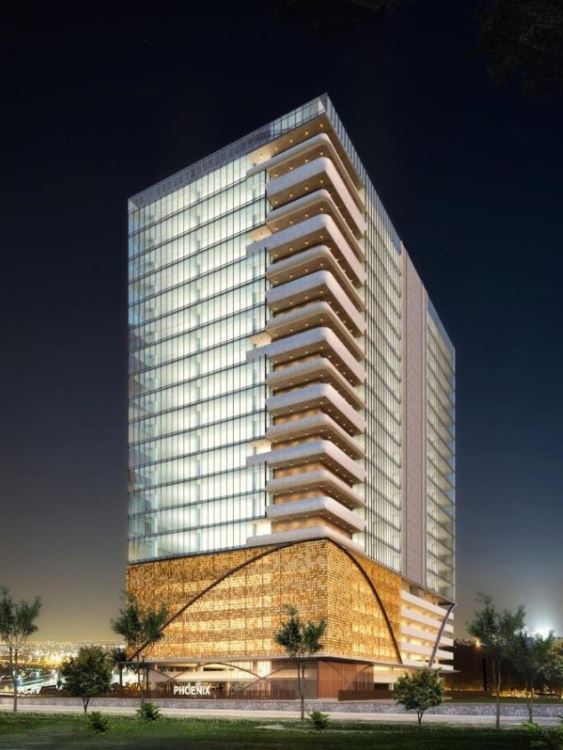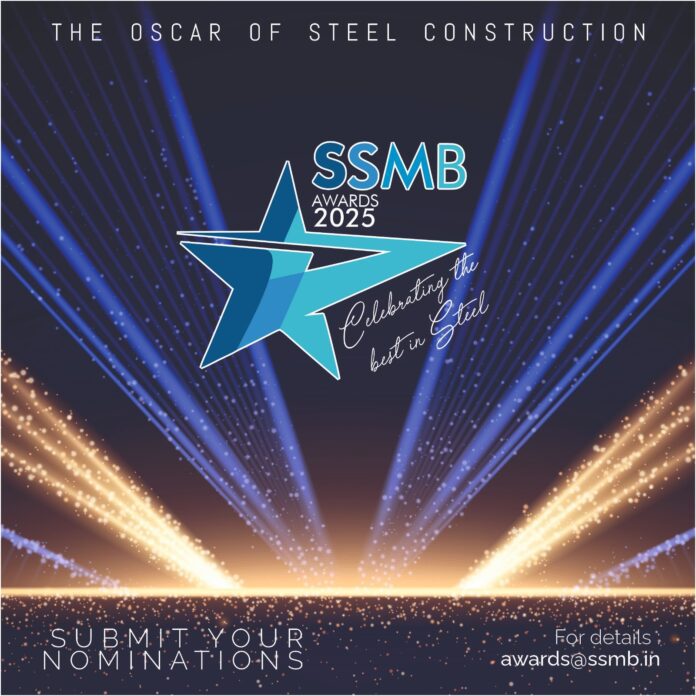Introduction: In the thriving commercial heart of Hyderabad’s Jubilee Hills, across from the tranquil greens of KBR Park, a striking new presence now commands attention. Phoenix Lithop, a 6,50,000 sq ft, steel-intensive commercial tower is more than a real estate project; it is an architectural and engineering declaration.
In the vibrant commercial centre of Hyderabad’s Jubilee Hills, overlooking the renowned KBR Park, a striking and innovative landmark tower rises prominently. Phoenix Group’s Lithop is situated on a 1.26-acre site, and its proximity to the national park allows the mixed-use development to integrate seamlessly within and benefit from the lush, abundant greenery.
Lithop is a 20-storey, 650,000 sq ft mixed-use office building that combines creative design elements with state-of-the-art, value-driven development that consistently exceeds the sum of its assigned parts.
Lithop demonstrates how ambition, technology, material innovation, and teamwork can unite to create office spaces that are equally flexible, adaptable, and future proof. Designed by RSP Design Consultants (India) in collaboration with Strudcom Consultants, Lithop’s comprehensive steel structural design merges innovative aesthetics with engineering ingenuity to produce flexible and adaptable layouts that help save valuable construction time.
A VISION ROOTED IN STRATEGY & PLACE
For Phoenix Group, Lithop is a direct extension of a carefully articulated development vision. As Kalyan Chakrawarthy Kethana, AVP at Phoenix Group, explains, the company’s focus has always been on delivering Grade-A office spaces in high-value, strategically located urban zones. “Lithop blends location, design, and future-ready infrastructure. Situated amidst the elite precincts surrounding KBR Park in Jubilee Hills, Hyderabad, it is designed to deliver a tenant experience that competes on a global stage”
Harshita Atluri, VP Concept Design at Phoenix Group, further elaborates on the design philosophy and concept, emphasising how the architectural vision harmonises environmental sensitivity with a dynamic urban presence, creating spaces that inspire and engage occupants through innovative architectural elements.
“The choice of site, 1.26 acres directly opposite KBR Park, was not incidental. It allowed the development to integrate environmental and experiential quality into its DNA” says Harshita. Floor-to-ceiling glazing without spandrel panels opens uninterrupted vistas to the park, a rarity in commercial architecture that typically favours privacy and modular facade rhythms. The building’s zinc-clad kinetic skin over its stilts animates the lower levels, subtly interacting with wind and light to create an ever-changing play of shadow and movement.
Harshita further adds, “But beyond visual drama, the location demanded logistical ingenuity. The site’s 20 ft natural sheet rock mound required specialist excavation. Its placement in a high-density traffic corridor meant access was tight, and every movement of material and machinery had to be choreographed,” she concludes. These factors underscored the need for precision planning, resource coordination, and a structural system that could meet aggressive timelines without sacrificing quality.
“Every movement of material and machinery had to be choreographed — precision planning was not an option, it was survival.”
HEIGHT, LIGHT, & HUMAN EXPERIENCE
RSP Design Consultants, led by Director George Verghese on this project, approached Lithop as both a landmark and a workplace. The architectural strategy was to elevate the primary office floors well above street level, creating an immediate connection with the treetops of KBR Park while mitigating noise and pollution.
An 8-9 m level difference between the front and rear of the site was turned into a defining design asset. The result: one-and-a-half basements and seven stilt levels of parking lift the first office floor to the eighth level. This move gives tenants commanding views while freeing the ground plane for circulation, access, and the kinetic facade expression.
“Lithop’s layered massing creates both functional clarity and urban drama,” Verghese notes. “The lower levels serve the building’s operational and service needs, while the upper floors are entirely devoted to prime workspace with maximum flexibility.”
The 14 office floors above the parking decks are configured for adaptability. Floor plates can be taken by a single large tenant or divided into multiple occupiers, with each module having dedicated washrooms and MEP provisions. Refuge balconies are integrated as per NBC 2016, and circulation is handled via lift banks accessed from double-height north and east lobbies. The terrace is not an afterthought: it houses a café, open-air gym, futsal court, and seating nooks, turning the building’s crown into a social and wellness hub.
A DEFINING STRUCTURAL CHOICE
The decision to adopt a steel composite structure was central to achieving Lithop’s performance targets. As Chakrawarthy recalls, the team needed a construction system that could accelerate timelines, allow large spans, and maintain flexibility for future tenant fit-outs. Structural steel offered all of these advantages and more.
From the outset, Strudcom Consultants saw the opportunity to innovate. Nikhil Inamdar, Director at Strudcom, proposed an unconventional all-steel core, replacing traditional reinforced concrete shear walls with steel plate walls tied with rods and filled with concrete. This approach reduced wall thickness, improved floor efficiency, and streamlined construction sequencing.
“Structural steel was the heart of the project,” Inamdar says. “By designing both the core and floors in steel, we could assemble modules quickly, maintain tighter tolerances, and complete a massive volume of superstructure in just nine months.”
The superstructure uses concrete-filled tube (CFT) columns and built-up I-beams. The CFTs sized at 450×450 mm and 600×600 mm across most floors carry gravity loads, while the steel plate core handles 100 per cent of lateral loads from wind and seismic events. Column spans of 8-12 m give tenants open, flexible interiors, with minimal interruptions from structural elements.
“A massive 6,50,000 sq ft of superstructure was completed in just nine months — proof of steel’s unmatched efficiency.”
ENGINEERING CONCEPT TO ON-SITE REALITY
Lithop’s structural system was developed with execution in mind. The GFC (Good for Construction) package was finalised before foundation work began, enabling shop drawings for steel fabrication to be prepared and validated without delay. Prefabricated components were then brought to site for rapid assembly, minimising urban disruption and ensuring consistent quality.
Thermal expansion, vibration control, and fire safety were addressed at the design stage. All columns achieved a two-hour fire rating using intumescent coatings, while beams were protected with vermiculite. Vibration limits were calculated and adhered to in sizing steel members.
Logistics posed their own challenges. Given the site’s location in Jubilee Hills, movement of heavy steel components had to be sequenced with care. Construction was phased: critical tower elements were prioritised, followed by non-tower works such as the STP and underground tanks. During the pandemic, when labour was scarce, the efficiency of steel assembly proved invaluable.
ARCHITECTURAL EXPRESSION MEETS STRUCTURAL PRECISION
While steel enhanced performance, it also enabled flexibility and clarity in design expression. The most distinctive design feature, the parametric zinc-clad kinetic skin over the stilts, required precise integration with the structural steel framework. The facade’s upper double-glazed section maximises daylight while reducing solar heat gain, balancing transparency with thermal comfort.
Inside, steel’s ability to carry long spans without intermediate supports made it possible to create column-free interiors that can adapt over time to changing tenant needs. In high-density commercial districts, such adaptability is a premium asset, enhancing the building’s long-term leasing appeal.
“The kinetic skin responds to wind and light, turning the building’s lower levels into a living, breathing sculpture.”
SUSTAINABILITY & FUTURE-READINESS
Steel’s recyclability and prefabrication benefits aligned naturally with Phoenix Group’s sustainability goals. By reducing on-site waste and water usage compared to conventional RCC construction, the project lessened its environmental footprint. Shorter construction timelines also meant reduced disturbance to the surrounding neighbourhood.
“For us, sustainability is not just about certifications,” says Chakrawarthy. “It is about delivering projects that are efficient to build, easy to maintain, and adaptable for decades to come.”
Inamdar echoes this view from an engineering standpoint. Steel, he notes, enables modular construction methods that are inherently resource-efficient and compatible with future disassembly or repurposing. Verghese adds that the building’s elevated positioning, natural light optimisation, and amenity integration contribute to its environmental and human sustainability.
A STATEMENT IN THE SKYLINE
Hyderabad’s commercial skyline is evolving rapidly, with global corporations seeking high-spec office spaces that can support advanced technologies, flexible work models, and employee wellbeing. Lithop addresses these demands head-on. Its prominent location, innovative structure, and refined aesthetic, position it as both a competitive asset in the leasing market and a design reference point for future developments. “Lithop sets a new standard for office buildings in the city,” Verghese affirms. “It is contextually sensitive, technically advanced, and visually memorable.”
For Phoenix Group, Lithop is both a business success and a brand statement. For RSP, it is a demonstration of architecture’s ability to negotiate challenging sites while delivering high-performance environments. For Strudcom, it is proof that steel can and should be the material of choice for ambitious, time-bound, and technically complex projects.
LOOKING AHEAD
Lithop’s completion is not the end of its story; it is the beginning of its role in shaping how Hyderabad works, collaborates, and innovates. As India moves toward its $5 trillion economy goal, projects like Lithop illustrate the potential of steel construction to meet the pace and scale of national ambitions.
Inamdar sees the building as part of a broader shift: “The role of structural consultants is evolving. We must guide clients and architects toward systems that not only perform today but remain adaptable tomorrow.”
For Chakrawarthy, the project affirms Phoenix Group’s position as a market leader unafraid to push boundaries. And for Verghese, it is a reminder that great buildings are as much about human experience as they are about technical achievement.
Lithop stands, then, not just as a tower of glass and steel, but as a vision realized. One where design, engineering, and strategy converge to create a new benchmark in Indian commercial architecture.
“Lithop blends location, design, and future-ready infrastructure. Situated amidst the elite precincts surrounding KBR Park in Jubilee Hills, it is designed to deliver a tenant experience that competes on a global stage.”
Kalyan Chakrawarthy, Associate VP, Phoenix Group
“Lithop is not just an office building, it is a design statement”.
Harshita Atluri, VP Concept Design, Phoenix Group
“Lithop’s layered massing creates functional clarity and urban drama. It is a workplace that feels open, light-filled, and connected to its surroundings.”
George Verghese, Director, RSP Design Consultants
“By designing both the core and floors in steel, we could assemble modules quickly, maintain tighter tolerances, and complete a massive volume of superstructure in just nine months.”
Nikhil Inamdar, Director, Strudcom Consultants
WHY STEEL WAS THE RIGHT CHOICE
- Faster Construction: Prefabrication cut erection time significantly
- Open Floor Plates: Flexible leasing configurations for tenants
- Sustainability: Steel is recyclable and reduced on-site waste
- Lightweight: Lower foundation loads and better seismic performance
Façade & Form: Where Architecture Meets Engineering
Lithop’s architectural drama is most visible in its dual façade expression:
- Lower Kinetic Skin: Zinc-clad panels over the stilts that respond to wind, creating a subtle shimmer and movement
- Upper Glass Curtain Wall: High-performance double glazing that maximises daylight and views, while controlling solar gain




